History Through Coinage - Vikings! Saxons! And War!
I have been meaning to write this post now for a couple of weeks but have just now found time to sit down and do it. I've had some changes in my life and my spare time has become fleeting.
It might be long but there is quite a bit to cover. So here goes nothing.
There are many distinct periods of Anglo-Saxon coinage. The earlier phases generally consisted of pale gold or base gold Thrymsas. These were generally small golden coins weighing in the neighborhood of 1.00-1.2 grams. They copied many motifs from their neighbors in continental Europe, the Merovingian's and Carolingian's, who in turn had copied from the Late Roman silver Siliqua. This was prestige coinage and would not have been in common hands but likely circulated between Kings, Chieftains and Clergy, serving as tribute or gift. These pieces fetch quite the price on the current market and still reflect that prestige. I do not own any of them.
As the Anglo-Saxon Kingdoms and Chiefdom's evolved and expanded trade we start to see a switch from gold to silver. A merchants and warriors tool. Many of the motifs and even size of the coinage remained the same but here in its silver form gains a new name. The Sceatt. This is where we will begin our look for the day.
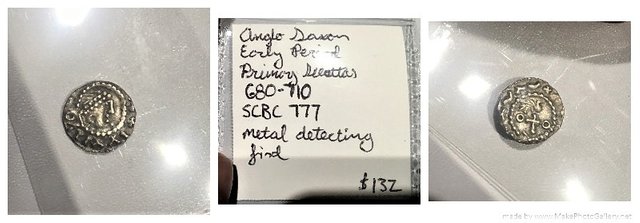
This is a fairly prototypical example of what was circulating in England around 700 AD. The obverse is a bust of some unknown ruler, truly just a copy of a copy of an older coin. Circling the bust are letters, most often Latin alphabet, they do occasionally sneak in some Runic from time to time. The reverse features a bird atop a cross, Christianized, this would have been a battle standard on the earlier influential Roman piece. I do like the touch of the ouroborous though, the snake encircling only to find itself eating its own tail.
There are many different variations of this coin as many different moneyers and engravers were making them, as well as every silver planchet being hand struck. This wasn't the only variety of Sceatt circulating at this time but it was one of a few.
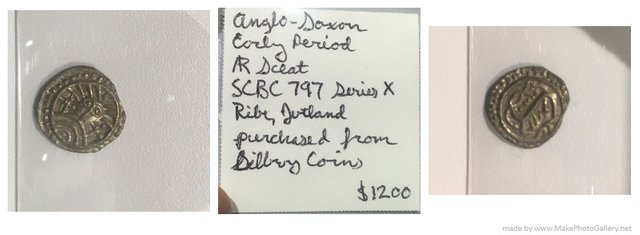
This is one of my favorite pieces that I have been able to acquire. It is different from most of the Anglo-Saxon Sceatts from this earlier period in that it was not minted on the Isle but in mainland Europe. The Jutland peninsula to be exact in the Viking trade center of Ribe. Right out of the gate the viking and pagan influence is forefront as the obverse of the coin features the visage of Wodan, or Odin. The reverse of the piece features an animal of some fantastic design, perhaps a dragon or other beast of legend, these heraldic and fantastic beasts do come into play on other coinage as well as we swill soon see one again.
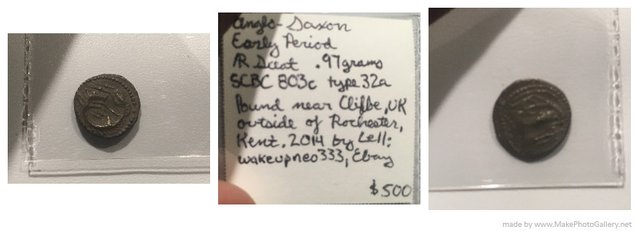
It is the very nature of this older and smaller coinage to have been lost over the years and is generally found by local metal detectorists across the English countryside such as this piece. It has a very dark earthen patina and the reverse is in much better shape than the obverse hence I have it shown first on the left hand side. This isn't uncommon as under the ground these coins are afforded both protection and exposure to uncertain elements. I think, however, in this case that the obverse was just poorly and weakly struck at the time of production, perhaps from a worn die. The sharp reverse however is a wonderful example of the typical early Kentish Sceatt. Featuring a curled wolf the detail and depth is hard to capture on such a small piece and poor camera such as my phone. The obverse, which is not only weakly struck but an even poorer picture, is another bust, facing right and carrying a scepter or staff of some sort perhaps topped with a cross.
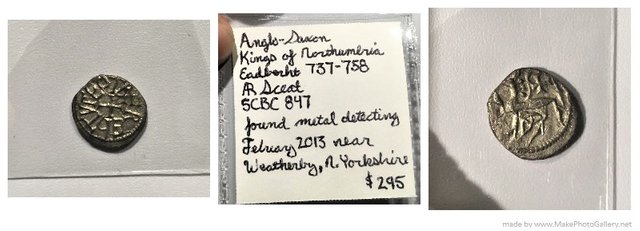
As we push later into the 8th century it is in Northumbria that the Sceatt continues its reign as the popular coin and also begins to take on the name of the ruler. The kingdoms in the South at this time begin to develop what will become known as the all too familiar silver penny. This coin was minted during the reign of Eadberht of Northumbria. The obverse of the coin, as we will see becomes quite typical, is the Kings name encircling a small cross motif. The reverse here again is a fantastic beast, likely heraldic to Eadberht. The reverse also features a tri-quatra below the beast and a cross above. There are many variations of this coin with some truly fantastic and artistically rendered reverses. I wish mine was of this sort but you take what you can get.
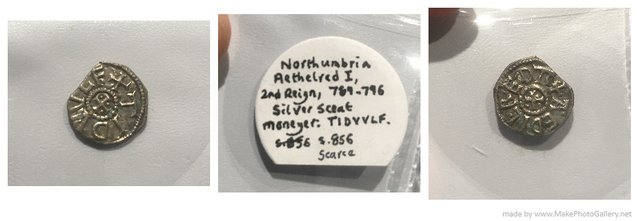
Later still yet in the 8th the Sceatt has lost much of its artistry and now serves strictly as a functional coin and advertisement for the ruler and moneyer in charge of producing the coin. This is a coin of Aethelred I of Northumbria. The Latinized name around the centralized cross motif is now the norm and we see it on both sides of the piece. The reverse here (I have them flipped in the pic) is the same as the obverse and features the name Tidvulf. A man and name altogether lost to history except through the legacy of coin production for his liege.
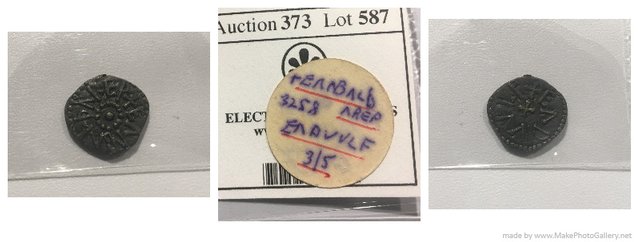
The turn of the 8th/9th century in Northumbria began quite a tumultuous time. We see the mighty silver Sceatt that had dominated the landscape for more than a hundred years turn into the debased and soon to be entirely copper, Styca. This Styca was produced in the name of Archbishop Eanbald. The power struggles between the ruling classes and clergy were very real at this time, rife with petty and civil war. It is no wonder that the seat of power in Northumbria, York, was such an easily conquered prize for the soon to arrive Vikings.
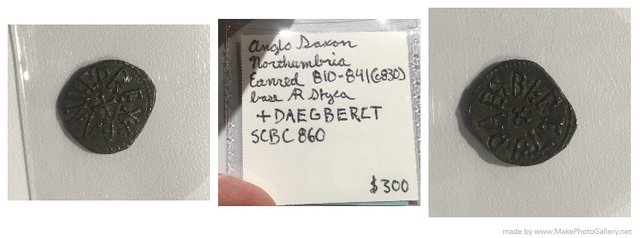
The long reign of King Eanred saw some stability back to the region and in turn an improvement in the local coinage. The Stycas produced during this period are quite numerous and actually do have some small amount of silver to them. The later coins not so much as the early. As with the previous two coins the name of King and moneyer are depicted on both sides surrounding the cross.
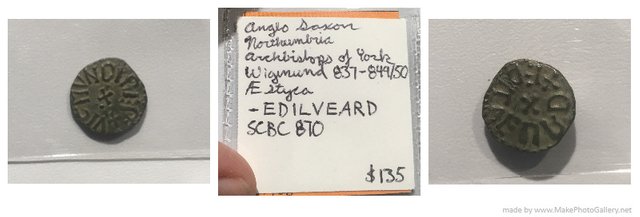
Another Arch Bishop, how boring, this Styca was minted in the name of Wigmund. He also seems to have held his position for quite some time until his death and would have had many dealings with the seated ruler in York, the aforementioned Eanred. Debased, copper and wholly unattractive such is the world of the Styca.
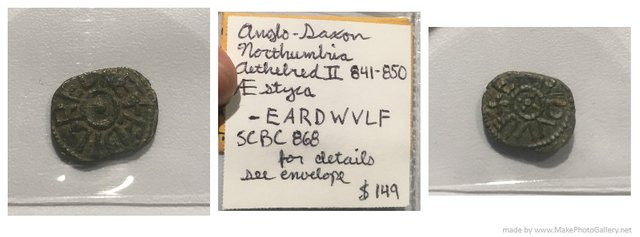
This is the last of my Stycas. Again, we have an overlapping timeline, Northumbria was a bit rougher than its Southernly neighbors. War and strife, usurpers, sons and clergy. I'm sure it was a regular Game of Thrones! Anyways, this is a copper Styca of Aethelred II of Northumbria. Now we can move on and get into some more interesting stuff again.

As the 9th century draws to a close York is in the hands of Viking invaders. This particular issue is that of Cnut of Northumbria. A Danish ruler his lineage and timeline are slightly obscured as is common during periods of power change and turmoil. This also began the period of Danelaw in which the Danish rulers extricated a heavy tax on the local populace known as the Danegeld. I particularly enjoy the design of this coin and they have now foregone the earlier Sceatt and Styca type coinage and adopted the silver penny as it was in common usage to the Southern and Continental kingdoms.
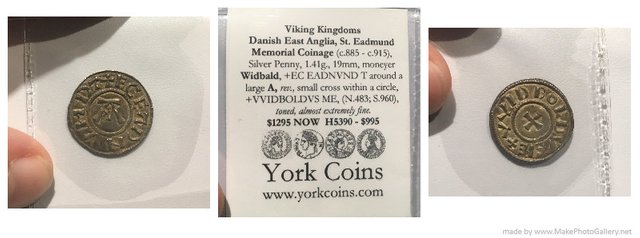
While Northumbria was under siege in the North so to was East Anglia in the South. This coin is a memorial coin minted in the name of Edmund the Martyr. If anyone has watched or read The Last Kingdom series by Bernard Cornwell then you well know the fate of King Edmund as it is depicted in that series in a highly fictionalized version. Another very nice silver penny, the large A on the obverse for Anglia and the moneyers name on the reverse. The Danish kingdoms at this juncture were beginning to throttle down on the middle of the country and very much so the, Last Kingdoms of Saxondom.

I'm afraid at this point we must leap ahead some years as I have a bit of a gap in my collection. Alfred the Great and his sons and grandsons have driven the Great Heathen Army from the shores of England and well and truly formed the first United Kingdom. No more were Wessex and Essex and East Anglia and Northumbria and Kent. Just England, one man's dream. This penny, which has some really nice rainbow toning not really apparent in the picture, was a coin of Aethlred II, The Unready. Aethelred II had two reigns as King of England and although the Danes had been banished, they were stepping up their coastal raids. And then Invasion!
Its a bit hard to see on my awful photos but if you look closely you can see what is known as 'peck marks' on the surface of the coin. These were done by viking warriors to make sure of the purity of silver in the coin.
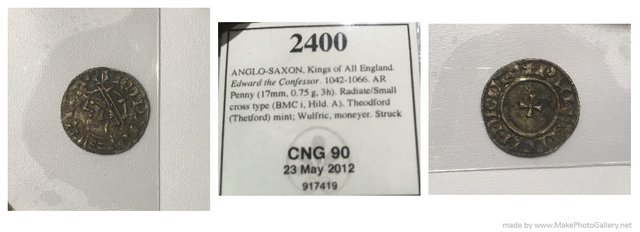
Skipping past the invasion and the placement of a Viking King of All England in Cnut the Great, we have this ugly little underweight penny of Edward the Confessor. This guy is pretty much the set-up to the next invasion of England, this time by the Normans and William I, the Conquering Bastard. Never again will there be a successful invasion of England, it is slightly ironic though that the Normans were literally the descendants of the North Men or Viking invaders to the North of France in the 9th century, so in a roundabout way the Vikings kind of got their kingdom after all.
What makes this particular coin special is the combination of mint and moneyer. When I purchased this coin it was the only known example of this particular combination in existence! Now, that doesn't mean that one day some one won't dig up a hoard of them but for now.............
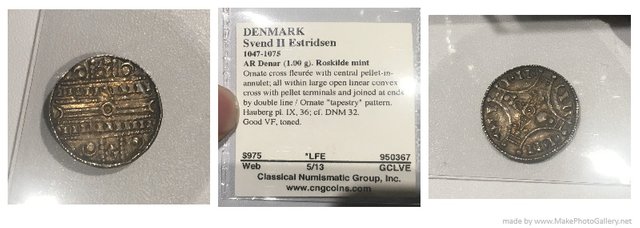
So this coin is not at all English but it seems a good place for it for now. This is a coin of Sven Estridsen. He was King of Denmark and I believe held joint rule maybe of parts of Norway with another Viking King, Harald Hardrada, another major player in the 1066 drama. Minted in Denmark at Roskilde, literally Red Shield, I love everything about this coin. Stave runes and shield boss, this is the close of the Viking Age.
@calluna P.S. sorry I missed entering your last contest!

